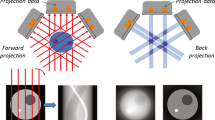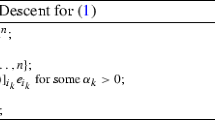Abstract
Diffusion tensor imaging has shown promise in the early detection and diagnosis of a host of disorders and neurologic conditions. In this paper, we propose a nonrigid registration approach for diffusion tensor images using a multicomponent information-theoretic measure. Explicit orientation optimization is enabled by incorporating tensor reorientation, which is necessary for wrapping diffusion tensor images. Experimental results on diffusion tensor images indicate the feasibility of the proposed approach and a much better performance compared to the affine registration method based on mutual information in terms of registration accuracy in the presence of geometric distortion.














Similar content being viewed by others
References
Basser P J, Mattiello J, Le Bihan D (1994) MR Diffusion tensor spectroscopy and imaging. Biophys J 66(1):259–267
Patil R A, Ramakrishnan S (2014) Analysis of sub-anatomic diffusion tensor imaging indices in white matter regions of Alzheimer with MMSE score. Comput Methods Prog Biomed 117(1):13– 19
Rovaris M, Gass A., Bammer R., Hickman S., Ciccarelli O., Miller D., Filippi M. (2005) Diffusion MRI in multiple sclerosis. Neurology 65(10):15261532
Alexander D C, Pierpaoli C, Basser P J, Gee J C (2001) Spatial transformations of diffusion tensor magnetic resonance images. IEEE Trans Med Imaging 20(11):11311139
Jones D, Griffin L, Alexander D, Catani M, Horsfield M, Howard R, Williams S (2002) Spatial normalization and averaging of diffusion tensor MRI data sets. NeuroImage 17(2):592617
Guimond A, Guttmann C, Warfield S, Westin C (2002) Deformable registration of DT-MRI data based on transformation invariant tensor characteristics. Proc ISBI:1–4
Xu D, Mori S, Shen D, van Zijl P, Davatzikos C (2003) Spatial norMalization of diffusion tensor fields. Magn Reson Med 50(1):175–182
Ruiz-Alzola J, Westin C-F, Warfield S, Nabavi A, Kikinis R (2002) Nonrigid registration of 3D tensor medical data. Med Image Anal 6(2):143–161
Alexander D, Gee J, Bajcsy R (1999) Elastic matching of diffusion tensor MRIs. Proc CVPR:244–249
Zhang H, Yushkevich P, Alexander D, Gee J (2006) Deformable registration of diffusion tensor MR images with explicit orientation optimization. Med Image Anal 10(5):764–785
Cao Y, Miller M, Mori S, Winslow R, Younes L (2006) Diffeomorphic matching of diffusion tensor images. Proc CVPR
Hecke W, Leemans A, D’Agostino E, De Backer S, Vandervliet E, Parizel P M, Sijbers J (2007) Affine coregistration of diffusion tensor magnetic resonance images using mutual information. IEEE Trans Med Imaging 26(11):1598–1612
Park H J, Kubicki M, Shenton M, Guimond A, McCarley R, Maier S, Kikinis R, Jolesz F, Westin C F (2003) Spatial normalization of diffusion tensor MRI using multiple channels. NeuroImage 20 (4):1995–2009
Thirion J P (1998) Image matching as a diffusion process: an analogy with maxwells demons. Med Image Anal 2(3):243– 260
Anderson A (2001) Theoretical analysis of the effects of noise on diffusion tensor imaging. Magn Reson Med 46(6):1174–1188
Irfanoglu M O, Nayak A, Jenkins J, Hutchinson E B, Sadeghi N, Thomas C P, Pierpaoli C (2016) DR-TAMAS: Diffeomorphic Registration for tensor accurate alignment of anatomical structures. Neuroimage 132:439–454
Seif M, Mani L Y, Lu H, Boesch C, Reyes M, Vogt B, Vermathen P (2016) Diffusion tensor imaging of the human kidney: Does image registration permit scanning without respiratory triggering?. J Magn Reson Imaging:1–8
Ben Hamza A, krim H (2003) Jensen-Rényi divergence measure: theoretical and computational perspectives. Proc IEEE Int Symp Information Theory
Khader M, Ben Hamza A (2011) Non-rigid image registration using an entropic similarity. IEEE Trans Inf Technol Biomed 15(5):681–690
Khader M, Ben Hamza A (2012) An information-theoretic method for multimodality medical image registration. Expert Syst Appl 39(5):5548–5556
Nocedal J, Wright S J (2000) Numerical optimization. Springer-Verlag, ch., New York, pp 8–9
Leemans A, Sijbers J, De Backer S, Vandervliet E, Parizel P M (2005) Nonrigid coregistration of diffusion tensor images using a viscous fluid model and mutual information. Proc ACIVS LNCS 3708:523–530
Taylor W D, Hsu E, Krishnan K R, MacFall J R (2004) Diffusion tensor imaging: background, potential, and utility in psychiatric research. Biol Psychiatry 55(3):201–207
Mori S, Zijl P (1995) Diffusion weighting by the trace of the diffusion tensor within a single scan. Magn Reson Med 33:41– 52
Tsallis C (1988) Possible generalization of Boltzmann-Gibbs statistics. J Stat Phys 52:479–487
Mattes D, Haynor D R, Vesselle H, Lewellen T K, Eubank W (2003) PET-CT Image registration in the chest using free-form deformations. IEEE Trans Med Imaging 22(1):120–128
Jones D, Horsfield M, Simmons A (1999) Optimal strategies for measuring diffusion in anisotropic systems by magnetic resonance imaging. Journal of Magnetic Resonance in Medicine 42(3):515–525
Author information
Authors and Affiliations
Corresponding author
Rights and permissions
About this article
Cite this article
Khader, M., Schiavi, E. & Hamza, A.B. A multicomponent approach to nonrigid registration of diffusion tensor images. Appl Intell 46, 241–253 (2017). https://doi.org/10.1007/s10489-016-0833-8
Published:
Issue Date:
DOI: https://doi.org/10.1007/s10489-016-0833-8




